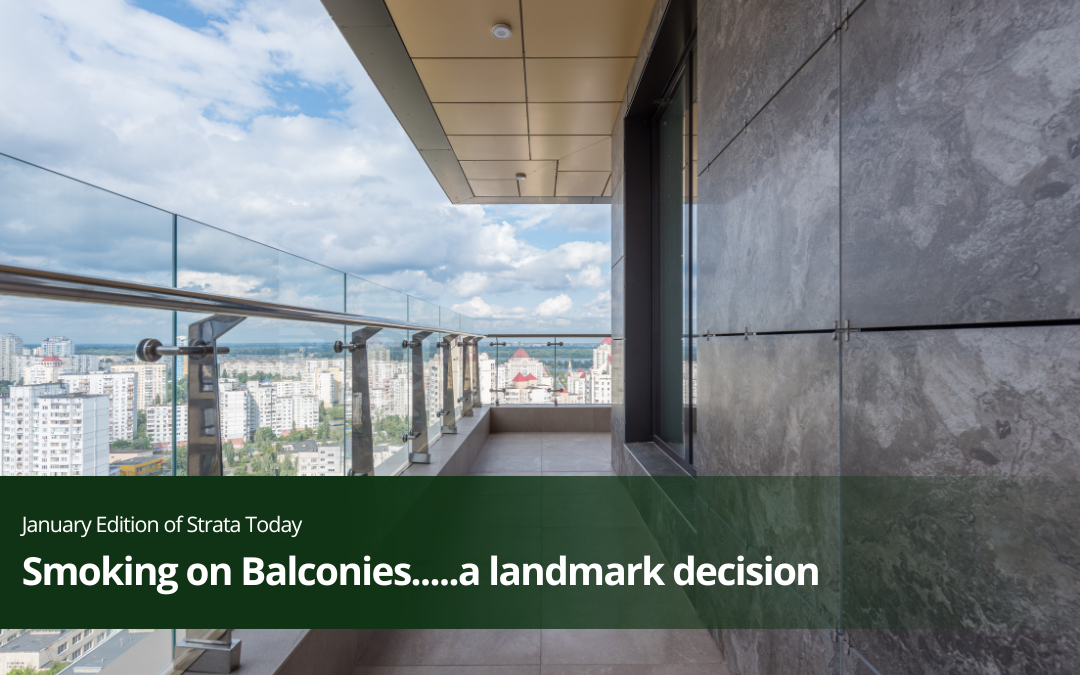As you may have seen on the news and in announcements being made across the Qld Strata Sector recently the Office of the Body Corporate Commissioner have made an order that has the potential to change the way complaints regarding occupants smoking on balconies are viewed and responded to. Historically the onus has been on an applicant to demonstrate that the volume of smoking was to such an extent that it constituted a nuisance. This conceivably involved overly onerous processes such as monitoring air quality or the volume of smoke via specialist devices. This recent decision has the potential to change that by lowering the burden of proof from demonstrating that smoking is a nuisance to that of smoking being a hazard.
In the application made by a lot owner within the Gold Coast scheme, it was claimed that the owner of the unit below (the respondent) chain smoked and second hand smoke was drifting into her unit which was a nuisance and was also causing a health hazard and as such was in breach of the by laws for the scheme.
The adjudicator, in reviewing the by laws for the scheme, noted that the by law that had been included in relation to smoking mirrored the wording of Section 167 of the Act but focussed specifically on smoking. The adjudicator also noted that there was no definition of ‘nuisance’, ‘hazard’ nor unreasonable interference’ in the Act – and instead referred to cases that had been though the New South Wales Civil and Administrative Tribunal (NCAT) for their interpretations of these. She further noted that those jurisdictions had regularly found that smoking in a strata community could be a nuisance and a hazard. She then referenced an NSW adjudicator finding that stated “The inhalation of second-hand smoke is a hazard. It is adjudged as such by public health legislation”. The adjudicator then went on to reference various pieces of government health advice that identified second hand smoke as being a hazard.
In considering all of the information and the submissions made by the respondent and other owners in the scheme, the Adjudicator noted:
Although smoking is not inherently illegal, controls exist on smoking in many contexts within the community because of its potential to harm others. The Body Corporate has chosen to include smoking controls in its by-laws. Section 167 of the Act applies in any event. On balance, I am satisfied the respondent’s smoking on Lot 805 is causing a hazard to those using the Lot, such that it is a breach of By-law 5 and section 167(a) of the Act. ] I consider orders to address this conduct are warranted.
What does this all mean?
Section 167 of the BCCM Act states:
The occupier of a lot included in a community titles scheme must not use, or permit the use of, the lot or the common property in a way that—
- causes a nuisance or hazard; or
- interferes unreasonably with the use or enjoyment of another lot included in the scheme; or
- interferes unreasonably with the use or enjoyment of the common property by a person who is lawfully on the common property
The Adjudicator in this instance somewhat put the nuisance issue to the side and instead focussed on the fact that second hand smoke constituted a hazard and that there is evidence to suggest it is not safe to be exposed to. That is a new approach and has the potential to be the precursor to significant change in how adjudicators consider any future applications regarding smoking, pending any potential appeal.
Importantly the respondent will continue to be able to smoke within the lot provide they take reasonable steps to ensure that smoke drift does not affect neighbouring lots so this is not the beginning of non smoking buildings. It can however been seen as a positive first step for many who have been impacted by second hand smoke from nearby lots.
A full copy of the order can be found here.
